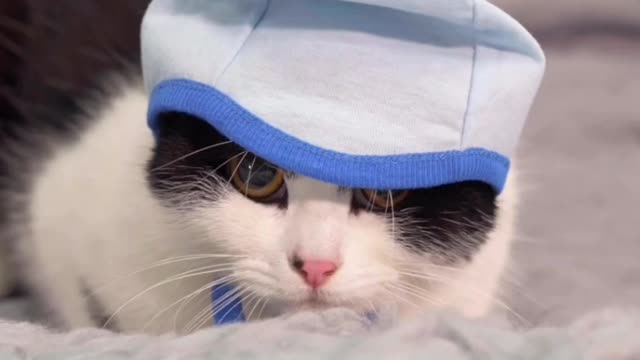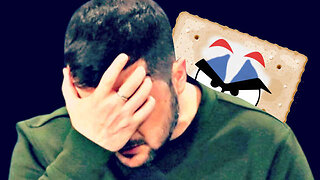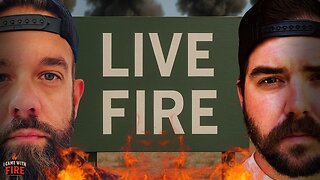Premium Only Content

Cute cat wants to hide on bed.
The domestic cat has a smaller skull and shorter bones than the European wildcat.[60] It averages about 46 cm (18 in) in head-to-body length and 23–25 cm (9–10 in) in height, with about 30 cm (12 in) long tails. Males are larger than females.[61] Adult domestic cats typically weigh between 4 and 5 kg (9 and 11 lb).[44]
Skeleton
Cats have seven cervical vertebrae (as do most mammals); 13 thoracic vertebrae (humans have 12); seven lumbar vertebrae (humans have five); three sacral vertebrae (as do most mammals, but humans have five); and a variable number of caudal vertebrae in the tail (humans have only three to five vestigial caudal vertebrae, fused into an internal coccyx).[62]: 11 The extra lumbar and thoracic vertebrae account for the cat's spinal mobility and flexibility. Attached to the spine are 13 ribs, the shoulder, and the pelvis.[62]: 16 Unlike human arms, cat forelimbs are attached to the shoulder by free-floating clavicle bones which allow them to pass their body through any space into which they can fit their head.[63]
Skull
Cat skull
The cat skull is unusual among mammals in having very large eye sockets and a powerful specialized jaw.[64]: 35 Within the jaw, cats have teeth adapted for killing prey and tearing meat. When it overpowers its prey, a cat delivers a lethal neck bite with its two long canine teeth, inserting them between two of the prey's vertebrae and severing its spinal cord, causing irreversible paralysis and death.[65] Compared to other felines, domestic cats have narrowly spaced canine teeth relative to the size of their jaw, which is an adaptation to their preferred prey of small rodents, which have small vertebrae.[65] The premolar and first molar together compose the carnassial pair on each side of the mouth, which efficiently shears meat into small pieces, like a pair of scissors. These are vital in feeding, since cats' small molars cannot chew food effectively, and cats are largely incapable of mastication.[64]: 37 Although cats tend to have better teeth than most humans, with decay generally less likely because of a thicker protective layer of enamel, a less damaging saliva, less retention of food particles between teeth, and a diet mostly devoid of sugar, they are nonetheless subject to occasional tooth loss and infection.[66]
Claws
Shed claw sheaths
Cats have protractible and retractable claws.[67] In their normal, relaxed position, the claws are sheathed with the skin and fur around the paw's toe pads. This keeps the claws sharp by preventing wear from contact with the ground and allows the silent stalking of prey. The claws on the fore feet are typically sharper than those on the hind feet.[68] Cats can voluntarily extend their claws on one or more paws. They may extend their claws in hunting or self-defense, climbing, kneading, or for extra traction on soft surfaces. Cats shed the outside layer of their claw sheaths when scratching rough surfaces.[69]
Most cats have five claws on their front paws, and four on their rear paws. The dewclaw is proximal to the other claws. More proximally is a protrusion which appears to be a sixth "finger". This special feature of the front paws, on the inside of the wrists has no function in normal walking,but is thought to be an antiskidding device used while jumping. Some cat breeds are prone to having extra digits (“polydactyly”).[70] Polydactylous cats occur along North America's northeast coast and in Great Britain.[71]
Ambulation
The cat is digitigrade. It walks on the toes, with the bones of the feet making up the lower part of the visible leg.[72] Unlike most mammals, it uses a "pacing" gait and moves both legs on one side of the body before the legs on the other side. It registers directly by placing each hind paw close to the track of the corresponding fore paw, minimizing noise and visible tracks. This also provides sure footing for hind paws when navigating rough terrain. As it speeds up walking to trotting, its gait changes to a "diagonal" gait: The diagonally opposite hind and fore legs move simultaneously.[73]
Balance
13:37
Comparison of cat righting reflexes in gravity and zero gravity
Most breeds of cat have a noted fondness for sitting in high places, or perching. A higher place may serve as a concealed site from which to hunt; domestic cats strike prey by pouncing from a perch such as a tree branch. Another possible explanation is that height gives the cat a better observation point, allowing it to survey its territory. A cat falling from heights of up to 3 meters (9.8 ft) can right itself and land on its paws.[74]
During a fall from a high place, a cat reflexively twists its body and rights itself to land on its feet using its acute sense of balance and flexibility. This reflex is known as the cat righting reflex.[75] A cat always rights itself in the same way during a fall, if it has enough time to do so, which is the case in falls of 90 cm (2 ft 11 in) or more.[76] How cats are able to right themselves when falling has been investigated as the "falling cat problem".
-
 15:23
15:23
T-SPLY
10 hours agoBUSTED Assistant Principle And Brother Arrested For Wanting To Kill ICE!
26.2K13 -
 22:06
22:06
Jasmin Laine
11 hours agoCBC STUNNED Into SILENCE After JD Vance’s BRUTAL Message to Canadians
19.6K12 -
 2:04:27
2:04:27
TimcastIRL
9 hours agoAntifa CONVICTED Of TERRORISM, Fears Of CIVIL WAR Grow | Timcast IRL
248K87 -
 2:16:43
2:16:43
TheSaltyCracker
7 hours agoIt's Over Zelensky ReeEEStream 11-21-25
88.4K132 -
 4:50:37
4:50:37
Drew Hernandez
1 day agoMIKE HUCKABEE EXPOSED FOR OFF RECORD MEETING WITH CONVICTED ISRAELI SPY?
54.8K23 -
 4:07:43
4:07:43
SynthTrax & DJ Cheezus Livestreams
17 hours agoFriday Night Synthwave 80s 90s Electronica and more DJ MIX Livestream SYNTHWAVE / ANIME NIGHT
39.2K1 -
 14:25
14:25
Tactical Advisor
15 hours agoReal Life John Wick Suit | Grayman & Company
25K2 -
 LIVE
LIVE
I_Came_With_Fire_Podcast
15 hours agoAlien Enemies Act | Dismantling the Department of Education | Valhalla VFT & America First
283 watching -
 19:53
19:53
MetatronHistory
6 hours agoRome VS Greece - Ultimate Clash of Civilizations Explained
14.3K4 -
 33:09
33:09
Exploring With Nug
8 hours ago $5.71 earnedThey Weren’t Ready for Nightfall on Blood Mountain… So I Helped Them Down
32.9K1